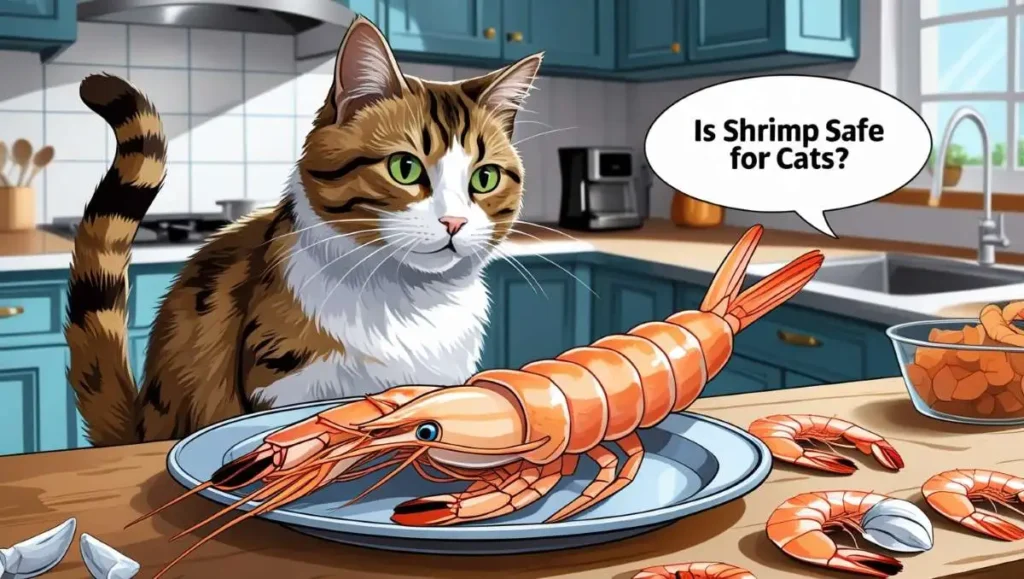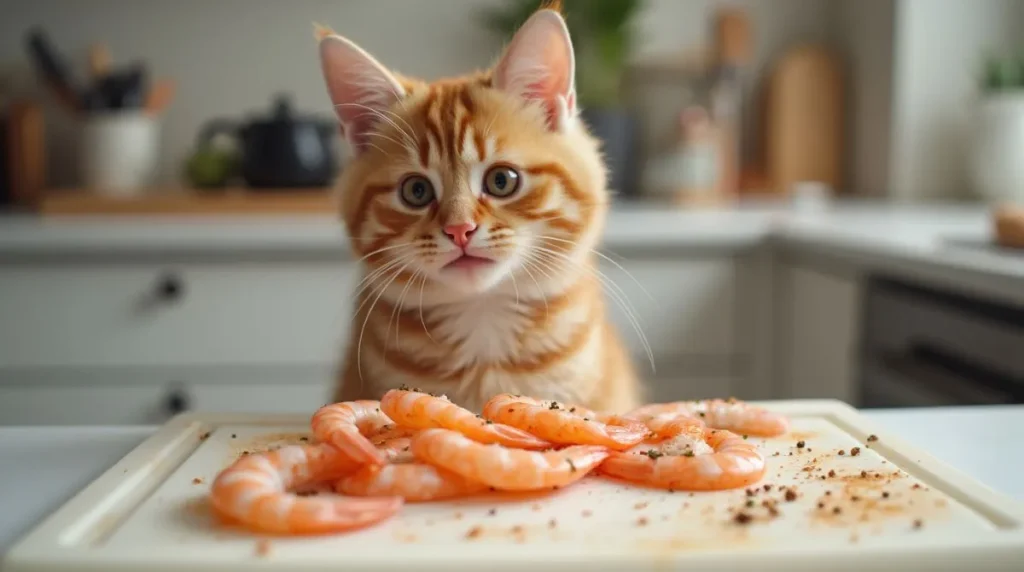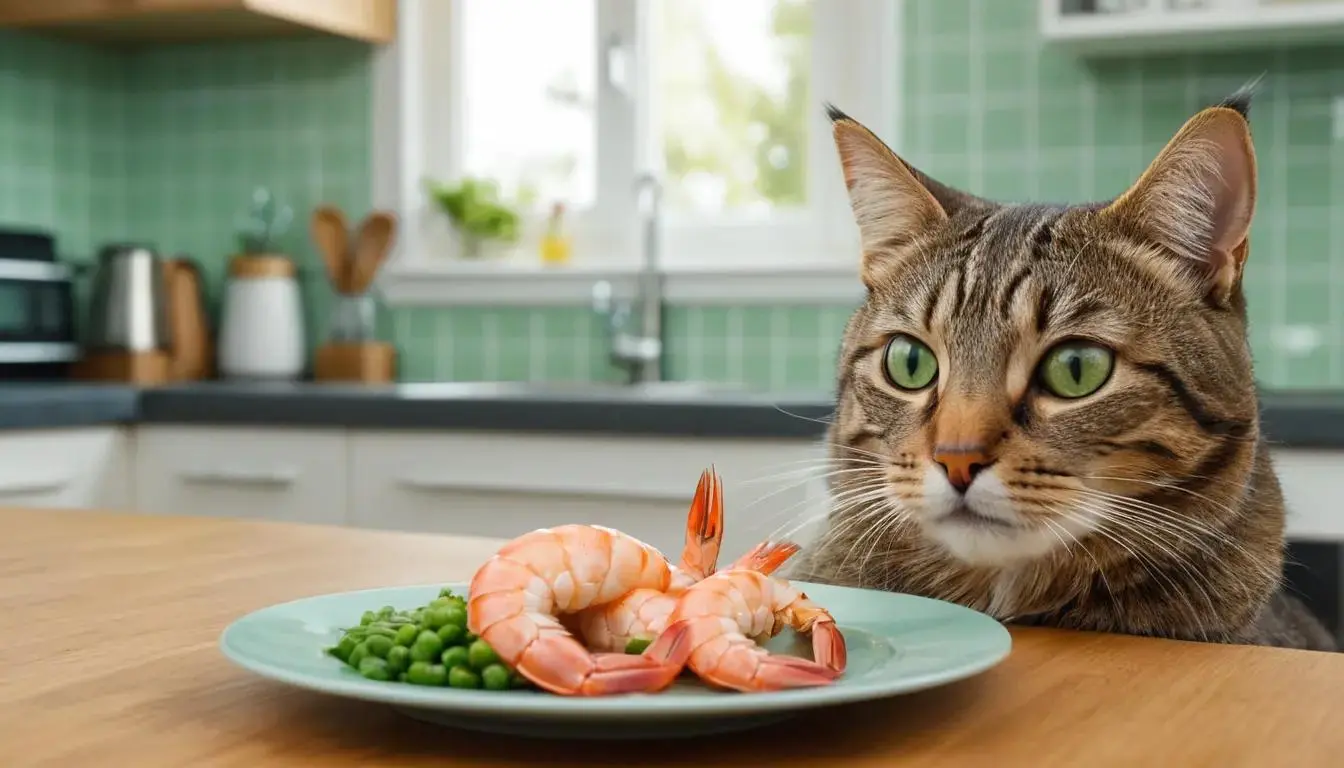Introduction About Can Cats Eat Shrimp?
If you’ve ever wondered, “Can cats eat shrimp?”, you’re not alone. Shrimp is a popular seafood that many pet owners consider offering as a treat to their feline friends. While shrimp can be a healthy snack, there are important safety guidelines you need to follow. From preparing the shrimp properly to understanding potential health risks, it’s essential to make informed decisions. In this article, we’ll explore 10 powerful tips to ensure your cat enjoys shrimp safely and without any harm. Whether you’re a new cat owner or just curious about adding variety to your cat’s diet, these tips will help you make the right choice.
Table of Contents
Is Shrimp Safe for Cats to Eat?
Shrimp is a flavorful and nutrient-packed snack for cats, but it’s essential to recognize both its positive effects and possible risks. Here’s a closer look at whether shrimp is safe for your feline friend:
Nutritional Benefits of Shrimp for Cat
Shrimp is an excellent source of high-quality protein, which is essential for maintaining your cat’s muscle mass and overall health. It also contains omega-3 fatty acids, which promote a shiny coat and healthy skin. Additionally, shrimp is low in calories, making it a great occasional treat for cats who are overweight or prone to obesity. Vitamins like B12 and minerals such as zinc and selenium found in shrimp can further support your cat’s immune system and metabolism. However, shrimp should be offered as a supplement to a balanced diet, not as a replacement.
Potential Risks of Feeding Shrimp to Cats
While shrimp is nutritious, it does come with potential risks. Cats can develop allergies or intolerances to seafood, and shrimp is no exception. Signs of an allergic reaction include vomiting, diarrhea, or excessive scratching. Another risk is choking or digestive blockage caused by shrimp shells or tails, which can be tough for cats to process. Additionally, shrimp that is seasoned or cooked with harmful ingredients like garlic, onion, or salt can be toxic to cats. Always ensure the shrimp you serve is plain, properly cleaned, and shell-free.
Raw vs. Cooked Shrimp: Which is Better for Cats?
The choice between raw and cooked shrimp is an important consideration. Raw shrimp can carry bacteria such as Salmonella or Vibrio, which can cause serious illness in cats. Cooking shrimp eliminates these pathogens, making it a safer option. Steaming or boiling shrimp without any added seasonings is the best preparation method. On the other hand, avoid fried or heavily processed shrimp, as they can contain unhealthy fats or additives that harm your cat. Ultimately, cooked shrimp in moderation is the safest way to treat your feline friend.

How to Safely Prepare Shrimp for Your Cat
Proper preparation of shrimp is essential to ensure it’s safe and healthy for your cat to enjoy. Below are detailed steps to help you serve shrimp safely, broken down into specific aspects:
Cleaning and Deveining Shrimp
Before offering shrimp to your cat, it’s crucial to clean and devein it thoroughly. Shrimp shells and tails can pose a choking hazard and are difficult for cats to digest. Remove the shell, legs, and tail completely, leaving only the soft, edible meat. Additionally, deveining the shrimp is important as the vein contains waste material that may upset your cat’s stomach. Rinse the shrimp under cold water to ensure all dirt and debris are removed, making it safe for consumption.
Cooking Methods for Cat-Safe Shrimp
Cooking shrimp properly is vital to eliminate harmful bacteria like Salmonella or Vibrio that can be present in raw seafood. The safest methods include steaming or boiling the shrimp without any added seasonings, oils, or butter. Avoid frying shrimp or cooking it with ingredients like garlic, onion, or salt, as these are toxic to cats. Once cooked, let the shrimp cool to room temperature before serving it to your feline friend.
Portion Sizes and Frequency
Shrimp should be given sparingly, as an occasional delight, rather than a consistent component of your cat’s meals. Offer small portions, such as half a shrimp or a bite-sized piece, depending on your cat’s size. Overfeeding shrimp can lead to digestive issues or unbalanced nutrition. A general guideline is to offer shrimp no more than once or twice a week. Monitor your cat’s reaction each time they consume shrimp to ensure they tolerate it well.
What Are the Benefits of Shrimp for Cats?
Shrimp can be a nutritious and delightful treat for cats when offered in moderation. Below, we explore the specific benefits shrimp can provide to your feline friend:
High-Quality Protein Source
Shrimp is an excellent source of lean, high-quality protein, which is essential for your cat’s overall health. Protein supports muscle maintenance, repair, and growth, keeping your cat strong and active. For obligate carnivores like cats, protein is a vital component of their diet, and shrimp provides it in an easily digestible form. Adding a small amount of shrimp to your cat’s diet occasionally can help meet their protein needs without adding excessive calories.
Omega-3 Fatty Acids for Skin and Coat Health
Omega-3 fatty acids found in shrimp contribute to a shiny coat and healthy skin. These healthy fats can reduce inflammation, support joint health, and even improve your cat’s cardiovascular system. If your cat suffers from dry skin, dandruff, or a dull coat, the omega-3s in shrimp may provide some relief. While shrimp alone can’t replace a balanced diet, it can serve as a supplementary source of these beneficial fats.
Low-Calorie Treat Option
For cats struggling with weight management, shrimp is a fantastic low-calorie treat. Unlike many commercial cat treats loaded with artificial flavors and excess fat, shrimp is naturally low in calories while still being flavorful and satisfying. It’s a guilt-free option for treating your cat without risking weight gain, especially for indoor or senior cats that may be less active.
Shrimp offers several nutritional advantages for cats, including high-quality protein, omega-3 fatty acids, and a low-calorie profile. By including shrimp as an occasional treat, you can provide a variety of nutrients that contribute to your cat’s overall well-being.
Potential Dangers of Feeding Shrimp to Cats

While shrimp can be a healthy treat for cats, it also comes with potential risks that pet owners should be aware of. Below, we explore the specific dangers associated with feeding shrimp to your feline friend:
Common Allergies and Symptoms
Cats, like humans, can develop food allergies or sensitivities, and shrimp is a common allergen among seafood. If your cat is allergic to shrimp, they may exhibit symptoms such as vomiting, diarrhea, excessive scratching, or swelling around the face or paws. In severe cases, shrimp allergies can cause breathing difficulties or anaphylaxis, which requires immediate veterinary attention. If you’re introducing shrimp to your cat for the first time, start with a small amount and closely monitor their reaction to avoid any serious health issues.
Contaminants in Shrimp
Shrimp can sometimes contain harmful contaminants, including bacteria like Salmonella or Vibrio, especially if it’s raw or undercooked. Additionally, farm-raised shrimp may carry traces of antibiotics, pesticides, or other chemicals used during farming. These substances can pose health risks to your cat if consumed. To minimize these dangers, always purchase high-quality, fresh shrimp from a trusted source and cook it thoroughly before offering it to your cat.
Overfeeding and Digestive Issues
Shrimp is a rich food that, when overfed, can upset your cat’s stomach. Overeating shrimp may lead to symptoms such as vomiting, diarrhea, or constipation. Cats require a balanced diet tailored to their nutritional needs, and too much shrimp can disrupt this balance, leading to nutrient deficiencies over time. To avoid these issues, treat shrimp as an occasional snack and not a staple in your cat’s diet.
Understanding the potential dangers of shrimp—such as allergies, contaminants, and digestive concerns—can help you make informed decisions about whether and how to include shrimp in your cat’s diet. By taking precautions and feeding shrimp responsibly, you can reduce these risks while still allowing your cat to enjoy this tasty treat.
Can Kittens Eat Shrimp? Special Considerations
When it comes to feeding kittens shrimp, there are additional considerations to keep in mind due to their developing bodies and unique nutritional needs. Below, we’ll explore whether shrimp is suitable for kittens and how to introduce it safely:
Is Shrimp Suitable for Growing Cats?
Kittens have specific dietary requirements, and their primary nutrition comes from high-quality kitten food designed to support rapid growth and development. Shrimp, while a nutritious treat, should not replace their main source of nutrients. The high protein content of shrimp can be beneficial, but it’s not balanced enough to provide all the necessary vitamins and minerals that kittens need for optimal growth. If you choose to offer shrimp, it should be an occasional supplement, not a regular part of their diet. Always ensure that your kitten’s primary diet consists of specially formulated kitten food that meets their nutritional needs.
How to Introduce Shrimp to Kittens
If you decide to give your kitten shrimp, it’s important to introduce it gradually and in small amounts. Start by offering a tiny piece of cooked shrimp and monitor how they react. Kittens have more sensitive stomachs than adult cats, so you should watch for signs of digestive upset, such as vomiting or diarrhea. Offering shrimp too soon or in large amounts can overwhelm their system. Introduce shrimp only after your kitten has adjusted to a solid diet and is well into the weaning process.
Warning Signs to Watch For in Kittens
Kittens are more susceptible to food allergies and sensitivities, and shrimp can sometimes trigger allergic reactions. If your kitten develops any symptoms such as excessive scratching, swelling, vomiting, or lethargy, stop offering shrimp immediately and consult your veterinarian. Additionally, be cautious about the size and texture of the shrimp. Shrimp shells can be difficult for kittens to digest and may present a choking hazard. Always remove the shells and tails before serving.
When feeding shrimp to kittens, it’s essential to approach it with care and moderation. While shrimp can offer certain benefits, it’s important to balance it with a kitten’s primary dietary needs and ensure that it’s introduced safely to avoid any digestive or allergic issues. Always consult your veterinarian if you have concerns about adding new foods to your kitten’s diet.

Tips for Encouraging Cats to Eat Shrimp Safely
Introducing shrimp to your cat can be a rewarding experience, but it requires careful preparation and moderation. Here are some tips to help you encourage your cat to enjoy shrimp while ensuring their safety:
Introducing Shrimp as a Treat
When first introducing shrimp to your cat, it’s important to present it in a way that appeals to their natural instincts. Cats are often drawn to the scent of seafood, so start by offering a small piece of shrimp in a familiar setting. You can place the shrimp in a dish alongside their regular food to see if they show interest. Don’t force them to eat it—let your cat explore the shrimp at their own pace. If they are hesitant, try offering it in smaller, bite-sized pieces to make it more manageable and less intimidating.
Creating Homemade Shrimp Treats
Homemade shrimp treats are an excellent way to entice your cat to eat shrimp while ensuring that it’s prepared safely. You can bake or steam shrimp without any added seasoning or oils, then chop it into small, cat-friendly pieces. Some cats may prefer shrimp mixed with a little bit of their favorite soft food or tuna juice for added flavor. Just be cautious not to overdo it with other ingredients, as you want to keep the shrimp the main focus. By making homemade shrimp treats, you can control the preparation process and ensure they are safe for your cat to consume.
Consulting with Your Veterinarian
Before incorporating shrimp into your cat’s diet, especially if your cat has a history of food sensitivities or allergies, it’s always a good idea to consult with your veterinarian. They can offer personalized advice on how much shrimp is safe for your cat, whether your cat has specific dietary restrictions, and how to introduce new foods safely. Additionally, your vet may suggest alternative seafood options that could be better suited for your cat’s needs. Consulting with a vet ensures that you’re making the best choice for your cat’s health and well-being.
Encouraging your cat to safely enjoy shrimp involves careful preparation, moderation, and attention to their individual preferences and needs. By following these tips, you can introduce shrimp in a way that’s safe and enjoyable for your feline friend.
FAQs:
This section addresses some of the most commonly asked questions regarding feeding shrimp to cats. These answers will help clear up any doubts and provide more detailed information on the topic.
Can Shrimp Harm Cats if Not Cooked?
Yes, raw shrimp can be harmful to cats due to the potential presence of bacteria such as Salmonella or Vibrio. These bacteria can cause serious illness in cats, leading to digestive upset, vomiting, or more severe health issues. It is essential to cook shrimp thoroughly before offering it to your cat. Boiling or steaming shrimp without any seasonings is the safest way to ensure your cat remains healthy and free from foodborne illnesses.
How Often Can I Give My Cat Shrimp?
Shrimp should be offered to your cat as an occasional treat, not as a regular part of their diet. While shrimp is rich in protein and omega-3 fatty acids, it lacks the full range of nutrients cats need, so it should never replace a balanced, high-quality cat food. Depending on your cat’s size and health, offering shrimp once or twice a week in small portions is typically enough. Overfeeding shrimp can lead to digestive issues or an imbalance in their diet, so it’s essential to keep it as a rare indulgence.
Are Shrimp Shells Dangerous for Cats?
Yes, shrimp shells can be dangerous for cats. Not only can they pose a choking hazard, but they are also difficult for cats to digest and can lead to gastrointestinal issues such as blockages or discomfort. It’s important to remove the shell, tail, and any legs from the shrimp before offering it to your cat. Only serve the tender, edible meat of the shrimp to ensure it’s both safe and easy for your cat to enjoy.
Can Cats Have Shrimp Tails?
Shrimp tails, like the shells, can be a choking hazard for cats, especially if they try to chew on them or swallow them whole. In some cases, the tails may also irritate a cat’s digestive system. To prevent any risk, always remove the tails before giving shrimp to your cat. Serving only the shrimp meat is the safest approach to ensure your cat enjoys their treat without any health concerns.
Is Shrimp Safe for Older Cats or Cats with Health Issues?
While shrimp can be a safe treat for most cats, older cats or those with health issues should have their diet monitored more carefully. If your cat has kidney disease, digestive issues, or is on a restricted diet, it’s always best to consult with your veterinarian before offering shrimp. For cats with these conditions, shrimp may not be the best treat, as it could aggravate their health problems or interfere with their prescribed diet.
Conclusion: Can cats eat shrimp?
In conclusion, shrimp can be a delightful and nutritious treat for cats when given in moderation and prepared correctly. While “Can cats eat shrimp?” is a question many pet owners ask, it’s important to understand both the benefits and the potential risks involved. Shrimp is packed with high-quality protein, omega-3 fatty acids, and essential vitamins, which can contribute to your cat’s overall health, including a shiny coat and strong muscles. However, feeding shrimp requires careful consideration of your cat’s individual needs and preferences, as well as proper preparation to avoid harmful contaminants or choking hazards.
As we’ve discussed, shrimp should always be cooked and free of seasoning, with the shell and tail removed to ensure it is safe for your cat. Offering shrimp as an occasional treat, not as a regular part of their diet, is the key to maintaining a healthy balance. If your cat has a history of allergies, digestive issues, or other health concerns, it’s always wise to consult your veterinarian before introducing any new food.
By following the tips and safety guidelines provided in this article, you can confidently answer the question, “Can cats eat shrimp?”. Whether you’re treating your feline friend to shrimp for the first time or considering it as a special occasional snack, remember that moderation is key, and always pay attention to your cat’s health and reactions.

